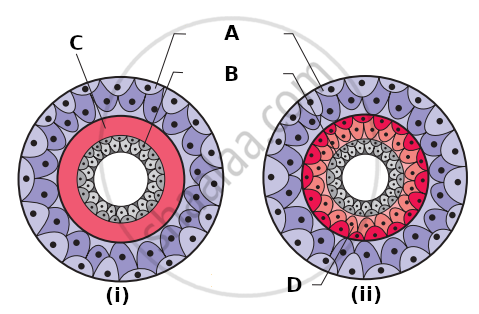Advertisements
Advertisements
Question
Body cavity is the cavity present between body wall and gut wall. In some animals the body cavity is not lined by mesoderm. Such animals are called ______.
Options
Acoelomates
Pseudocoelomates
Coelomates
Haemocoelomates
Solution
Body cavity is the cavity present between body wall and gut wall. In some animals the body cavity is not lined by mesoderm. Such animals are called pseudocoelomates.
Explanation:
(i) Acoelomate: The animals in which the body cavity is absent are called acoelomates, e.g.: Porifers, Coelenterates, Ctenophores and Platyhelminthes.
(ii) Pseudocoelomate: In some animals, the body cavity is not lined by mesoderm, instead, the mesoderm is present as scattered pouches in between the ectoderm and endoderm. Here body cavity is directly connected to the archenteron. Such a body cavity is called pseudocoelom and the animals possessing them are called pseudocoelomates. E.g.: Aschelminthes (Ascaris). Pseudocoelom is derived from blastocoel.
(iii) Coelomate: The body cavity, which is lined by mesoderm (on both sides) is called coelom. Animals possessing coelom are called coelomates, or coelom is a cavity between the alimentary canal and body wall enclosed by mesoderm on both sides. E.g.: Annelids, Arthropods, Molluscs, Echinoderms, Hemichordates and Chordates.
Depending upon its origin, true coelom or eucoelom is of two types:
(a) Schizocoelous: The coelom is formed by the splitting of mesoderm. E.g.: Annelida, Arthropoda and Mollusca.
(b) Enterocoelom: The coelom develops as an outgrowth of the enteron or embryonic gut. E.g.: Deuterostomia (Echinodermata and Chordata). Echinodermata is an enterocoelomate invertebrate.
APPEARS IN
RELATED QUESTIONS
If you are given a specimen, what are the steps that you would follow to classify it?
Distinguish between intracellular and extracellular digestion.
The following characteristics are essential for classification.
Match the following columns and select the correct option.
| Column – I | Column – II | ||
| (p) | Pila | (i) | Devil fish |
| (q) | Dentalium | (ii) | Chiton |
| (r) | Chaetopleura | (iii) | Apple snail |
| (s) | Octopus | (iv) | Tusk shell |
Examine the figures of diploblastic (i) and triploblastic (ii) organization in animals given below and identify the labelled parts A to D.

In some animal groups, the body is found divided into compartments with serial repitition of at least some organs. This characteristic feature is called ______.
Match the following list of animals with their level of organisation.
| Division of Labour | Animal |
| Column I | Column II |
| A. Organ level | i. Pheretima |
| B. Cellular aggregate level | ii. Fasciola |
| C. Tissue level | ii. Spongilla |
| D. Organ system level | iv. Obelia |
Choose the correct match showing division of labour with animal example.
Sort out the animals on the basis of their symmetry (radial or bilateral) coelenterates, ctenophores, annelids, arthropods, and echinoderms.
What is the relationship between germinal layers and the formation of body cavity in case of coelomate, acoelomates and pseudocoelomates?
Animal with bilateral symmetry in ______.
